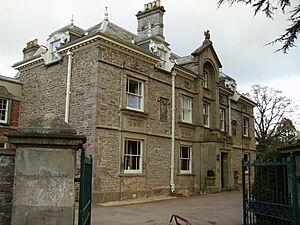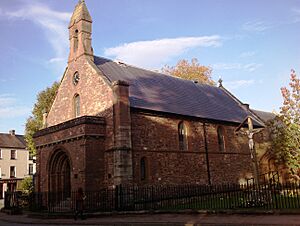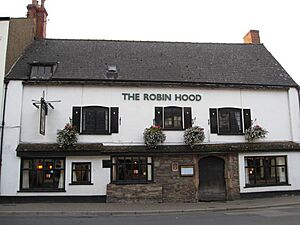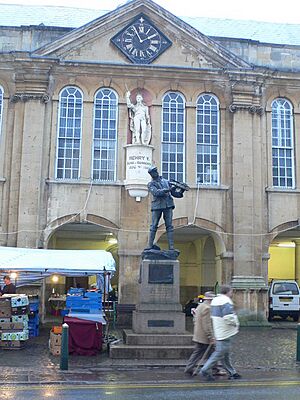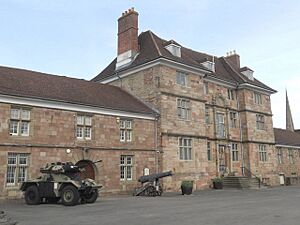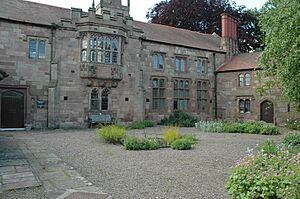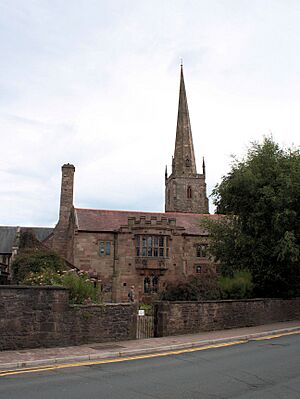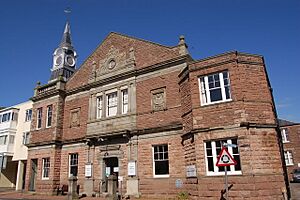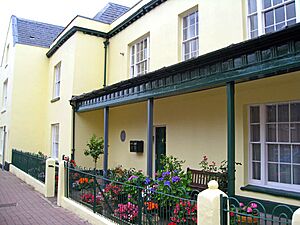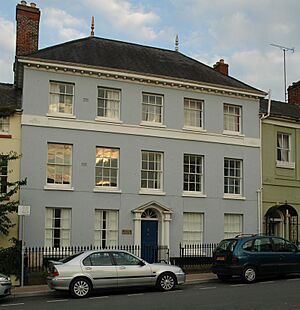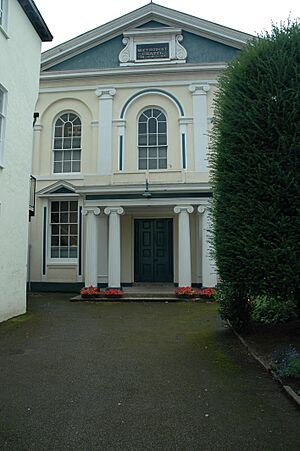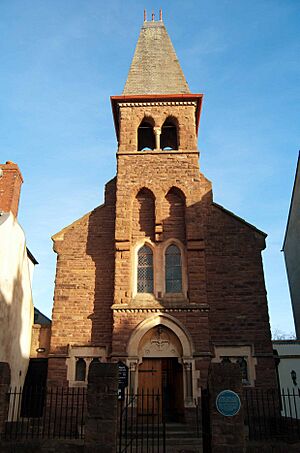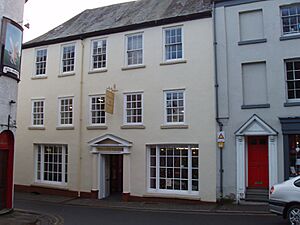Monmouth Heritage Trail facts for kids
The Monmouth Heritage Trail is a fun walking route in the town of Monmouth, Wales. It helps you discover many cool and historic places. Imagine a treasure hunt where each stop tells a story about the town's past!
Discovering Monmouth's History
In 2009, a group called the Monmouth Civic Society wanted to help people learn about their town's amazing history. They picked 24 important buildings and decided to mark them with special blue plaques. These plaques were made by Ned Heywood from Chepstow. They are blue and have raised writing in both English and Welsh, telling a short story about each building.
Some buildings were easy choices, like the famous Monnow Bridge and the Shire Hall. These are like symbols of Monmouth! But the trail also includes hidden gems, such as The Nelson Garden or Monmouth Methodist Church, which many people might pass every day without knowing their history.
To make it even easier to explore, the "MonmouthpediA" project uses special QR codes. You can scan these codes with your phone to get lots of information about the town and its history, right as you stand there!
Understanding Building Grades
When you see old buildings, they often have a special "grade." This grade tells us how important and unique a building is. It helps protect these historic places for the future.
| Grade | What it Means |
|---|---|
| Grade I | These are buildings that are super special, sometimes even famous around the world! |
| Grade II* | These buildings are very important and have more than just a little bit of special history. |
| Grade II | These are important buildings for the country and have special historical value. |
Exploring the Heritage Trail Buildings
Here's a closer look at some of the amazing places you can find on the Monmouth Heritage Trail:
| No. | Name | Picture | Grade | Built Around | Location | What's Special About It | |
|---|---|---|---|---|---|---|---|
| 1 | Drybridge House | II* | 1671 | 51°48′32″N 2°43′24″W / 51.809°N 2.7233°W | Drybridge House is a large building from the 1600s. It's located near a "dry bridge" over a small stream. Today, it's used as the Bridges Community Centre, a place for everyone to enjoy. | ||
| 2 | St Thomas the Martyr Church | II* | c.1170 | 51°48′30″N 2°43′13″W / 51.8084°N 2.720408°W | This church is right next to the old Monnow Bridge. Parts of it are from around 1180, and it has a beautiful arch from the 12th century. Most of the outside was rebuilt in the early 1800s. | ||
| 3 | Monnow Bridge | I | 13 C | 51°48′32″N 2°43′12″W / 51.809°N 2.7200°W | Monnow Bridge is super special! It's the only medieval bridge in Great Britain that still has its gate tower standing. It crosses the River Monnow and is a very old and important monument. | ||
| 4 | Robin Hood Inn | II* | late medieval | 51°48′34″N 2°43′09″W / 51.8095°N 2.7193°W | The Robin Hood Inn is a pub with origins from the late medieval times. It's made of stone and has a wide doorway from the 1400s. It's a rare old building still standing in Monmouth. | ||
| 5 | Roman Fort | not listed | c. 55AD | 51°48′16″N 2°43′24″W / 51.80447°N 2.7233°W | Blestium was a small Roman fort and a place where they worked with iron. It's believed to be where Monmouth is today, near where the River Monnow meets the River Wye. | ||
| 6 | King's Head Hotel | II* | 17 C | 51°48′43″N 2°42′57″W / 51.811935°N 2.715721°W | The King's Head Hotel is a historic inn from the mid-1600s. It's said that King Charles I visited here in 1645. It has a cool black-and-white painted stone front. | ||
| 7 | Shire Hall | I | 1724 | 51°48′43″N 2°42′55″W / 51.811973°N 2.715404°W | The Shire Hall is a very important building in the town center, built in 1724. It used to be a courthouse and a market. It's a famous landmark in Monmouth. | ||
| 8 | Great Castle House | I | 1673 | 51°48′46″N 2°42′59″W / 51.8127°N 2.7164°W | Great Castle House was built where part of Monmouth Castle used to be. It's considered one of the most important buildings in town for its architecture. | ||
| 9 | Market Hall | II | 1830s | 51°48′47″N 2°42′55″W / 51.813°N 2.7154°W | The Market Hall is an early Victorian building from the 1830s. After a big fire in 1963, it was partly rebuilt. Now, it's home to the Monmouth Museum, where you can learn even more about the town's history. | ||
| 10 | Monmouth Priory | II* | 1075 | 51°48′49″N 2°42′51″W / 51.8135°N 2.71413°W | Monmouth Priory includes parts of old monastery buildings from 1075! It was later used as a school and is now a community center. | ||
| 11 | St Mary’s Priory Church | II* | 18 - 19 C | 51°48′48″N 2°42′50″W / 51.8132°N 2.714°W | St Mary's Priory Church started as a monastery in 1075. The church you see today was mostly built in the 1700s and 1800s. | ||
| 12 | Monmouth County Gaol | II | 1780s | 51°49′01″N 2°42′47″W / 51.817°N 2.713°W | The County Gaol was the main prison for Monmouthshire when it opened in 1790. It looked like a medieval fortress. It had a chapel, a place for sick people, living areas, and even a treadmill. It closed in 1869. | ||
| 13 | Rolls Hall | II | 1887 | 51°48′47″N 2°42′40″W / 51.813°N 2.711°W | The Rolls Hall is a Victorian building that is now a public library. It was given to the town in 1887 to celebrate Queen Victoria's Golden Jubilee. | ||
| 14 | Judges' Lodgings | II | 18c | 51°48′47″N 2°42′43″W / 51.81306°N 2.712°W | The Judges' Lodgings is an 18th-century building that was once an inn. It was later used as a place for judges to stay when they were in Monmouth for court cases. | ||
| 15 | The Dispensary | not listed | na | 1860s? | 51°48′47″N 2°42′38″W / 51.8130°N 2.7106°W | The Dispensary is a Georgian town house from the mid-1700s. It's a typical house for Monmouth's town center and stands in St James' Square. | |
| 16 | Monmouth Methodist Church | II* | 1837 | 51°48′43″N 2°42′36″W / 51.812°N 2.710°W | Monmouth Methodist Church was built in 1837. It has its original balconies, organ area, and a fancy pulpit. | ||
| 17 | St Mary's Roman Catholic Church | II | 1793 | 51°48′44″N 2°42′47″W / 51.812306°N 2.713°W | St Mary's Roman Catholic Church, built in 1793, was one of the first Catholic churches allowed in Wales after a long time. It has some later additions from the Victorian era. | ||
| 18 | Angel Hotel | II | 17 C | 51°48′46″N 2°42′51″W / 51.8127°N 2.7142°W | The Angel Hotel was an inn from the 1600s and was open for a very long time, until 1985. It has a roof made of Welsh slate. | ||
| 19 | Savoy Theatre | II* | 19C | 51°48′46″N 2°42′52″W / 51.81284°N 2.7145°W | The Savoy Theatre is a cinema and theatre that was updated in 1928. It's thought to be the oldest working theatre in Wales! It can hold 360 people and is now run by a charity. | ||
| 20 | The White Swan Inn | II* | rebuilt 1839 | 51°48′32″N 2°43′23″W / 51.809°N 2.723°W | The White Swan Inn was an old coaching inn from the 1700s. It has three floors and a large window on the ground floor. It was covered in white plaster in the early 1800s. | ||
| 21 | Agincourt House | II* | 17-19C | 51°48′45″N 2°42′54″W / 51.812472°N 2.715°W | Agincourt House is a cool half-timbered building from the early 1600s. It has been fixed up a lot, but a carving above the front shows the date 1624. | ||
| 22 | Beaufort Arms Hotel | II* | 1830s | 51°48′43″N 2°42′54″W / 51.812°N 2.715°W | The Beaufort Arms Hotel was another old coaching inn from the early 1700s. The front of the building might have been changed in the 1830s. You can still see "The Beaufort Arms" carved in stone. | ||
| 23 | Hyam's Mineral Water Works | not listed | na | 1866 | 51°48′40″N 2°42′50″W / 51.811°N 2.714°W | Hyam's Mineral Water Works is a 19th-century building that used to make soda water, lemonade, and ginger beer. It started in 1866 and is now used as apartments. | |
| 24 | The Nelson Garden | II* | nom.1802 | 51°48′40″N 2°42′56″W / 51.811°N 2.7156°W | The Nelson Garden is a 19th-century garden famous for a tea party held there in 1802 to honor Lord Nelson. You enter it through a short underground path in the old town wall. |


